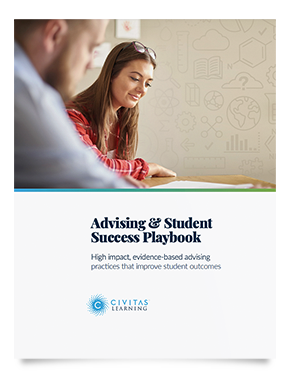
6 Ways to Deliver Personalized Student Support at Scale
Share this Post
Student success services work.
When tuned to the real-time needs of your students, success initiatives make a significantly positive impact on a student’s college experience. They’re an essential part of any campus’s student retention strategies and necessary in your effort to close achievement gaps, encourage persistence, and improve college completion.
But how do you consistently provide proactive, personalized student success service to a diverse student population with escalating needs, in a rapidly changing higher education landscape, with limited financial and human resources?
The ability to consistently provide impactful support to every student who needs it when they need it is possible.
We know it’s not sustainable to meet growing demands by investing more money and resources into tools, initiatives, and staff, only to get little or no change in your student outcomes. Scaling student success doesn’t have to mean doing more. It’s about making your efforts more effective.
To do that, your institution needs the right kinds of insights and the ability to coordinate data-informed action across your campus. Colleges and universities with effective, scalable student success programs use student success software to coordinate care across various professional roles and departments. These diverse cross-functional teams of administrators, faculty members, and staff look beyond historical and demographic data. They use all institutional student data to know the whole student story and work together to ensure students have the support they need this term.
This article explores how Civitas Learning partner institutions deliver effective student success interventions at scale despite shrinking resources. These strategies include:
- Create a Single Source of Truth
- Diagnose Underlying Problems
- Understand Student Success Initiative Effectiveness
- Prioritize Student Engagement
- Use Automated Communication with Caution
- Coordinate Student Care Across Departments
First, let’s examine why making strategic investments in student success services that improve outcomes on your campus is worth it.
Why Student Success Services are Worth the Investment
With increasingly constrained resources, we know investing in more initiatives or staff is challenging. Colleges and universities that successfully scale their student success services leverage their student impact data to become more efficient and effective. Clarity about what’s working allows administrators to allocate resources to the programs most benefit their students. Real-time visibility into student persistence predictions allows student success teams to prioritize outreach to the most vulnerable students and prescribe precise interventions when students need them most.
Many institutions that invest in data infrastructure and student success technologies see substantial returns on their investment. One Civitas Learning partner struggled to improve retention as operating costs per FTE increased by 36%. They found that expensive initiatives designed to keep students enrolled didn’t deliver their desired outcomes.
With the Civitas Learning Student Impact Platform’s initiative analysis capability, they discovered that their Center for Academic Reading (CAR) had a 5.9 percentage point overall lift in persistence, translating into a 3.4 percent return on investment for the college. Even though CAR costs the institution $138,000 a year in equipment, tutors, and coaches to staff the center, its positive impact on student outcomes allowed it to pay for itself.
Advising and Student Success Playbook
We know budget limitations can often stand in the way of meaningful change. Still, investment in the right student success software should improve the effectiveness of student success teams. Administrators, faculty, and student success staff equipped with real-time insights and a unified student success software not only know with certainty which students need support but can work together to take action to improve outcomes for the most vulnerable students.
Our partner institutions use six data-informed strategies to scale student success services:
6 Data-Informed Strategies to Scale Student Success
1. Create a Single Source of Knowledge
A campus-wide data infrastructure and culture equips colleges and universities to collect and consistently share data in actionable ways. This approach improves efficiency by breaking down information silos between campus departments that may know different parts of a student’s story. A single source of truth inside the Student Impact Platform empowers teams to organize around a specific priority and work from a shared and up-to-date understanding of their students.
The ability to access data collected from multiple inputs all in one place provides your student success team with current and comprehensive insights into everything that matters for your students. A comprehensive view of a student’s academic, behavioral, engagement, financial, and sentiment data offers a clear understanding of the student’s experience. This clarity helps improve the efficacy of student engagement efforts by allowing student success professionals to have a more holistic view of the student journey without spending precious time chasing down information.
How Institution-Specific Analytics Improve Student Outcomes
2. Diagnose Underlying Challenges
Immediate and sustainable improvement of student outcomes requires a closer look at the experience of specific students and student groups. While looking at trends and historical data when reviewing student enrollment, persistence, and completion metrics is important, predictive insights can help your institution identify gaps or unexpected shifts in your student outcomes.
You need your data analytics to tell you predicted student risk and, more importantly, what factors are creating that risk so you can make meaningful adjustments to processes, policies, curricula, and services. This shift to data-activated student impact strategies empowers your student success team to know what’s impacting success as early as possible. Allowing them to meet students where they are reduces friction and barriers, encourages successful behaviors, and ensures equitable outcomes.
Administrators, faculty, and advisors with access to student engagement data throughout the term can prescribe appropriate interventions as circumstances change for their students. This real-time insight into what’s currently happening in a student’s experience improves the effectiveness of interventions by enabling teams to coordinate proactive, personalized support when their students need it.
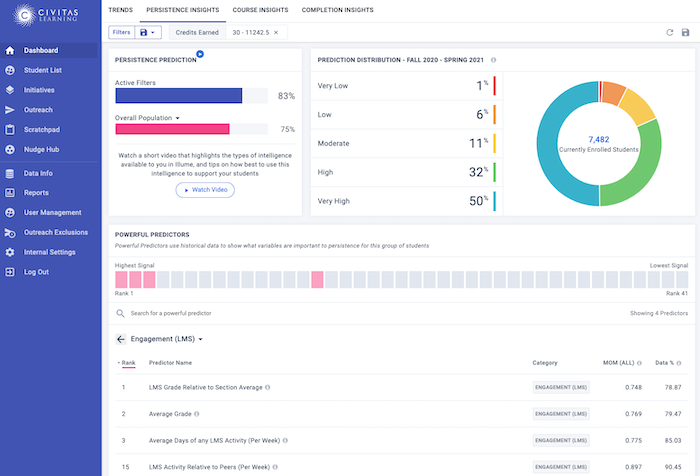
Why It’s Essential to Use Persistence as a Student Success Metric
3. Understand the Efficacy of Student Success Initiatives
Student success initiative effectiveness can vary widely from institution to institution, sub-group to sub-group, and student to student. Civitas Learning partners use a key student impact strategy to scale student success: understanding the efficacy of every policy, program, and initiative at their campus. Insight into what works for their students helps them know exactly which levers to pull to influence student success.
A real-time view of comprehensive data sets enables leaders to confidently reallocate resources to the most impactful initiatives in time to affect change. Clarity about the most beneficial interventions for specific students and student groups improves advisor and student success teams’ ability to connect their students with the most appropriate services and resources.
The ability to consistently evaluate the effectiveness of initiatives allows institutions to implement data-activated strategies to improve student outcomes this term. As higher education continues to serve a more diverse student population, insight into what benefits your students equips your institution to adjust and refine your approach—resulting in improved student outcomes like retention and completion.
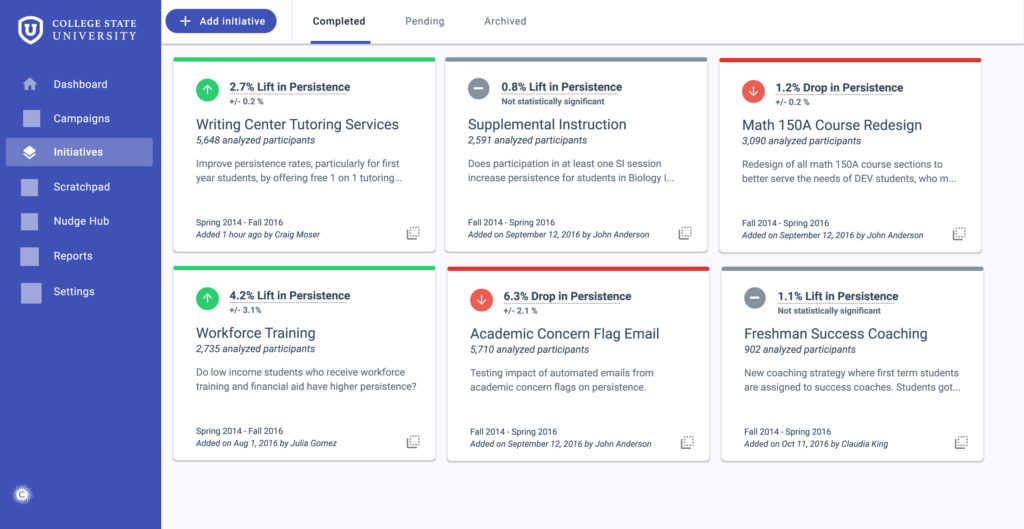
4. Prioritize Student Engagement
In our study with the Center for Generational Kinetics, students expected relationships with student success staff, especially advisors, to be personalized and proactive. More than anything, students want their advisors to know them, understand their current situation, and provide support that fits their needs. Hard-working advising teams often can’t consistently offer this level of proactive, personalized support to every student in their caseload.
Partners share that the students who are most likely to persist are the ones who often occupy most of their advisor’s time. Across our partner institutions, we found that advisors spend less than 30% of their time helping students who are less likely to achieve successful outcomes. Your student success software should relieve capacity challenges by allowing your advising staff to engage students around specific factors influencing their likelihood of success throughout the term. Real-time visibility equips advisors with the information they need to prioritize engagement with those students who don’t already seek out support before it’s too late.
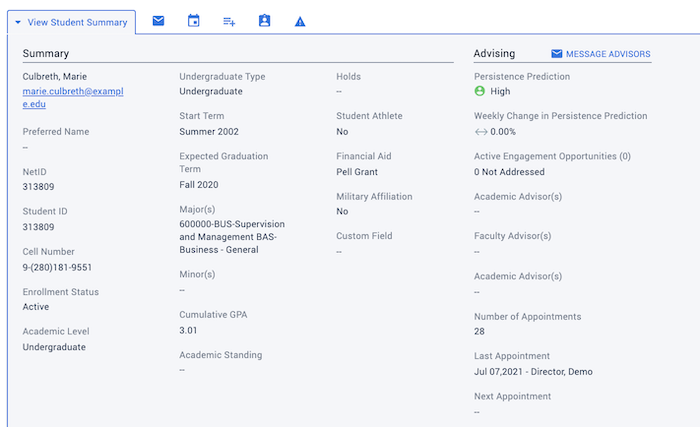
5. Use Automated Communication with Caution
When considering ways to scale communication, it’s tempting to use solutions like automated alerts to notify students of potential risks. Our study of a handful of colleges and universities with existing automated communication found that automated alerts and transactional messaging can result in -1 to -10 percentage point drops in persistence. We also found that personalized messaging rooted in a growth mindset resulted in a 1 to 10 percentage point lift in persistence. It’s clear. The way you communicate with students matters.
With the help of student success software like the Student Impact Platform, it is possible to communicate with students in scalable and personal ways. Your advisors and student success professionals can leverage your data intelligence to segment groups of students by various predictive factors and other criteria.
For example, suppose you notice a growing decline in the likelihood of degree completion among students of a specific college. In that case, you can further segment this student group by their likelihood of returning in the fall. For the students with a high probability to return in the fall, you can plan a nudge campaign with specific messaging encouraging them to participate in tutoring or remind them to schedule a routine advising appointment. But for the students who are less likely to return, you can prioritize more immediate interventions like scheduling an appointment or inviting them to attend office hours.
Student data can help you determine which channels are the most effective mode of communication for a particular student. Advising workflow solutions can provide essential insights and tools to help you craft personalized, growth-minded messaging that resonates with students. When student success professionals have the tools to build meaningful connections with their students, their work drives improved student engagement and success.
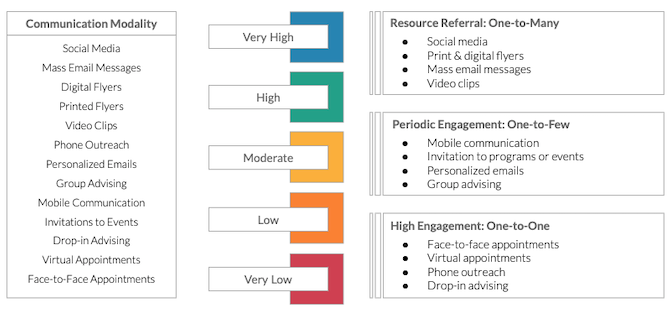
6. Coordinate Student Care Across Departments
A key student impact strategy for scaling student success is establishing cross-functional success networks to provide coordinated student care. To scale student success, your team needs your student success software to create a complete picture of their student’s journeys by unifying disparate data, predicting student outcomes, and uncovering barriers and risks as soon as possible. This shared understanding of real-time student risk and access to centralized information enables student success teams to take coordinated action to connect students to the resources they need to succeed.
In this way, student success becomes a campus-wide priority that involves a wide range of stakeholders at all institutional levels. It becomes a team effort that goes beyond traditional academic success programs like academic advising or tutoring. By working together, student success teams can scale their impact by avoiding duplication of efforts and addressing multiple factors impacting student outcomes.
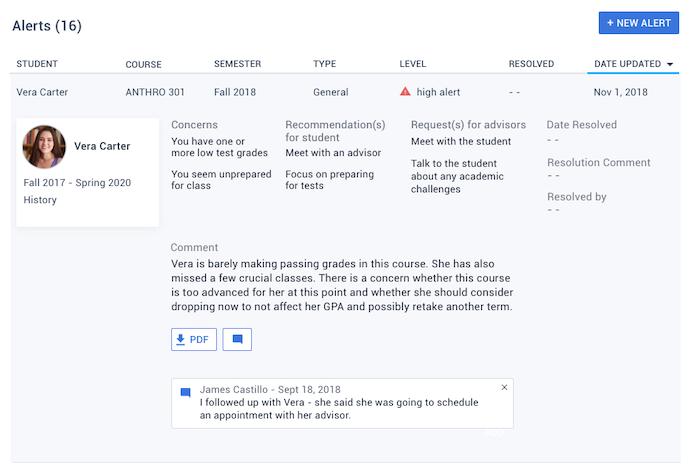
It’s Possible to Help Every Student Succeed
Delivering world-class student success services for every student is possible. Proactive, personalized support doesn’t have to mean standing up an expensive initiative or hiring more staff. Student success platforms, like the Civitas Learning® Student Impact Platform, make it possible for your team to impact every student and take immediate data-informed action to proactively boost persistence and increase on-time completion.
